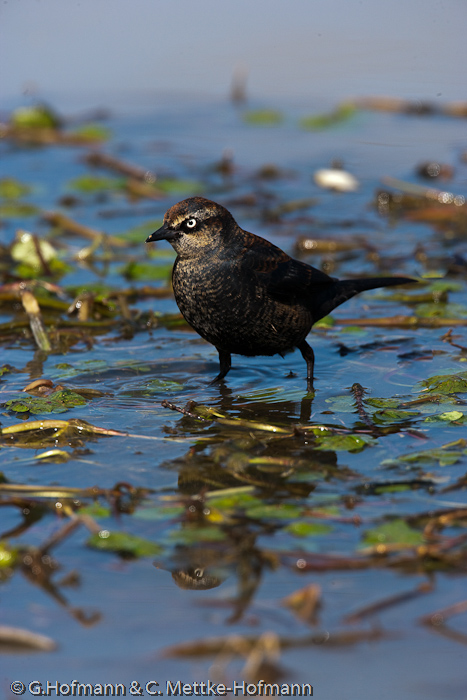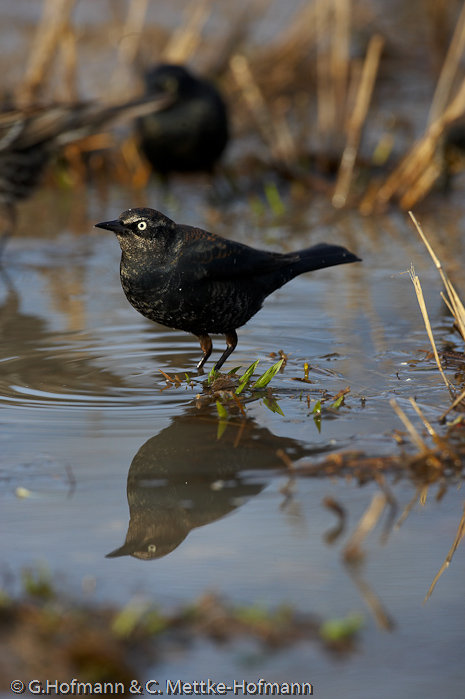Wintering
In September, Rusty Blackbirds begin the migration south from their breeding ground and arrive at the southernmost extent of their wintering range as early as November (Avery 1995, DeLeon 2012).
 Although their wintering distribution includes most of the southeastern United States, wintering Rusty Blackbirds are found in the highest numbers in the lower Mississippi Alluvial Valley and the southeastern Coastal Plain of the Carolinas and Georgia (Niven 2004, Hamel 2009). Rusty Blackbirds forage on the ground in primarily wet areas including flooded woods, swamps, marshes, and at the edges of water (Avery 1995). Although traditionally thought to be forested wetland specialists, they also use wet roadside ditches, lawns in yards and parks, open pastures, agricultural fields, and pecan orchards for foraging (Avery 1995, Luscier et al. 2010, DeLeon 2012). Recent research has shown that Rusty Blackbirds may not be as specialized as previously thought, possibly due to more diverse winter foraging requirements (Luscier et al. 2010, DeLeon 2012).
Although their wintering distribution includes most of the southeastern United States, wintering Rusty Blackbirds are found in the highest numbers in the lower Mississippi Alluvial Valley and the southeastern Coastal Plain of the Carolinas and Georgia (Niven 2004, Hamel 2009). Rusty Blackbirds forage on the ground in primarily wet areas including flooded woods, swamps, marshes, and at the edges of water (Avery 1995). Although traditionally thought to be forested wetland specialists, they also use wet roadside ditches, lawns in yards and parks, open pastures, agricultural fields, and pecan orchards for foraging (Avery 1995, Luscier et al. 2010, DeLeon 2012). Recent research has shown that Rusty Blackbirds may not be as specialized as previously thought, possibly due to more diverse winter foraging requirements (Luscier et al. 2010, DeLeon 2012).
During the winter Rusty Blackbirds frequently form small flocks, occasionally mixing with Common Grackles (Quiscalus quiscula), Red-winged Blackbirds (Agelaius phoeniceus), European Starlings (Sturnis vulgaris), and Brown-headed Cowbirds (Molothrus ater).
 Although large flocks are rare, flocks with 100 or more Rusty Blackbirds are sometimes seen. They characteristically flip over wet leaves to find aquatic invertebrates such as insects, spiders, snails, and crawfish. Birds do not wade into deeper water and most frequently use ponded areas with high amounts of litter and shallow water no higher than their legs (Luscier et al. 2010, DeLeon 2012). They can occasionally be found foraging on wet lawns with other blackbirds and American Robins (Turdus migratorius). One of the best times to see them in residential areas is right after a rain, where they can be found pulling up earthworms and other invertebrates that have been forced to the surface of lawns. Seeds and berries make up a larger part of their diet while wintering and they have been observed feeding on acorn fragments and small-seeded acorns, such as those from the water oak (Quercus nigra). They often feed on pecans that have already been broken into manageable pieces, either by Common Grackles, squirrels, cars, or other machinery (Luscier et al. 2010, Patti Newell, unpublished data).
Although large flocks are rare, flocks with 100 or more Rusty Blackbirds are sometimes seen. They characteristically flip over wet leaves to find aquatic invertebrates such as insects, spiders, snails, and crawfish. Birds do not wade into deeper water and most frequently use ponded areas with high amounts of litter and shallow water no higher than their legs (Luscier et al. 2010, DeLeon 2012). They can occasionally be found foraging on wet lawns with other blackbirds and American Robins (Turdus migratorius). One of the best times to see them in residential areas is right after a rain, where they can be found pulling up earthworms and other invertebrates that have been forced to the surface of lawns. Seeds and berries make up a larger part of their diet while wintering and they have been observed feeding on acorn fragments and small-seeded acorns, such as those from the water oak (Quercus nigra). They often feed on pecans that have already been broken into manageable pieces, either by Common Grackles, squirrels, cars, or other machinery (Luscier et al. 2010, Patti Newell, unpublished data).
Rusty Blackbirds exhibit high survival and nest success while breeding, indicating that forces acting in the winter range or during migration may be causing the Rusty Blackbird decline. The greatest threat to Rusty Blackbirds may be habitat loss and degradation on the wintering grounds (Greenberg and Matsuoka 2010). Boreal forests in the breeding range have been largely spared from development, but clearing of land in their winter range for agriculture and other uses has been ongoing since European settlement. Other factors such as disease and unusually high parasite loads while wintering, possibly due to increased stress, may also be playing a significant role in the decline (Barnard et al. 2010). Increasing habitat fragmentation may be exposing Rusty Blackbirds to predators and intensifying competition with more dominant blackbirds, which can use similar resources (Greenberg and Matsuoka 2010). Since they sometimes roost with “grain pest” blackbird species, pest control programs could be inadvertently exterminating Rusty Blackbirds. While habitat loss in the winter range may be the biggest threat to Rusty Blackbirds, knowledge of the combined negative effects of these factors is necessary for appropriate conservation planning.
REFERENCES
Avery, M. L. 1995. Rusty Blackbird (Euphagus carolinus). In The Birds of North America, No. 200 (A. Poole and F. Gill, eds.). The Academy of Natural Sciences, Philadelphia, and The American Ornithologists’ Union, Washington, D.C.
Barnard, W. H., C. Mettke-Hofmann, and S. M. Matsuoka. 2010. Prevalence of hematozoa infections among breeding and wintering Rusty Blackbirds. Condor: 112:849-853.
DeLeon, E.E. 2012. Ecology of Rusty Blackbirds wintering in Louisiana: Seasonal trends, flock composition and habitat associations. MS thesis. Louisiana State University and Agricultural and Mechanical College, Baton Rouge, LA.
Greenberg, R. and S. M. Matsuoka. 2010. Rusty Blackbird: Mysteries of a species in decline. Condor 112:770-777.
Hamel, P. B., and E. Ozdenerol. 2009. Using the spatial filtering process to evaluate the nonbreeding range of Rusty Blackbird, Euphagus carolinus, p. 334–340. In T. D. Rich, C. Arizmendi, D.W. Demarest, and C. Thompson [EDS.], Proceedings of the 4th International Partners in Flight Conference: Tundra to Tropics, McAllen, TX, 13–16 February 2008.
Luscier, J. D., S.E. Lehnen, and K.G. Smith. 2010. Habitat occupancy by Rusty Blackbirds wintering in the lower Mississippi alluvial valley. Condor 112(4):814-848. Niven, D. K., J. R. Sauer, and W. A. Link. 2004. Christmas Bird Count provides insights into population change in land birds that breed in the boreal forest. American Birds 58:10–20.
